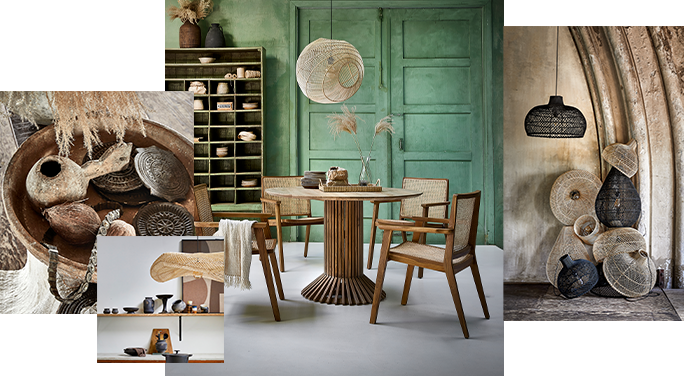
Our buyers travel the world to find furniture and accessories to enhance your home. With each journey, they bring back items with an interesting background story.
In this month’s ‘Story Of..’, we want to tell you more about our Martavan jars. Read more below.
History
The Mon people of Lower Burma established states in Pegu and Martaban. In Martaban, they established large pottery kilns to produce storage vessels such as this example which were used across Southeast Asia and even India and the Middle East to transport commodities such as dried fish, oil, grains, dried chills, and dried mango. It is likely that the jars were used again and again and were strapped into the holds of small trading vessels in the manner that the Romans transported wine and olive oil in amphorae around the Roman empire, or much like containers are used and re-used to ship goods on containers ships today.
Martaban jar is a generic term for large heavy stoneware jars shipped out of the port of Martaban. It doesn’t identify the origin where these jars were made as many jars exported from the port were made in China, Thailand, and Vietnam instead of from local kilns, which the different materials and styling could distinguish. During the Ming dynasty, this busy port was under the jurisdiction of Thailand. These jars were documented from the 14th century and the export lasted until Martaban ceased to be an important international port after the Burmese attack in 1613.
According to Fraser-Lu (1994, p. 201), Martaban jars were first mentioned in 1350 by the Moroccan traveler Ibn Battuta, who visited the port of Martaban.
Due to this trade, jars produced in Martaban were found in Thailand, Indonesia, the Philippines, Borneo, and India.
When not used for transporting goods, the jars were then re-purposed locally as storage jars often for rice or drinking water.
The various designs and functions of martaban jars demonstrate the dynamism that emerged with the expansion of maritime voyages during the early modern period of Southeast Asia.

Colonial times
Through 17th-century shipwrecks, it was discovered that martaban jars were a major trade for the Dutch East India Company (VOC) as they could effectively store items such as salted pork, opium, ginger, wine, gunpowder, and other items while being shipped from Coromandel to Batavia.
Differences in origin
The origins of martaban jars can be determined by their features such as their glaze, colour, decorations, size, and lugs
The general description for martaban jars is “large, brown to almost black, glazed jars”. They usually have broad shoulders and “thick-lipped narrow mouths”. The glaze conventionally has a “poured effect” that results in the natural clay at the bottom remaining exposed
While most of the martaban jars in the collection of museums were made in Guangdong province, southern China, the color and chemical composition of glazes reveal the exchanges in pottery traditions in Asia. The technique of glazing the jars is said to have been introduced to Burma by Dvavarati traditions, as confirmed through an examination of glazed pottery in U-Thong, Thailand. Other styles of glazing include the ash-colored natural glaze, known in Japan as “dragonfly eye”, found in jars from the Tang dynasty (618-907), leather-textured glazes claimed to be of Manchu origin under the Yuan dynasty (1279-1368) and lead glaze which was a predominant style in Burma.


Other cultures
These jars do not just have great commercial and aesthetic value, they have also become imbued with memories of ancestry, love, life, and death as heirloom items (peska or pusaka) to indigenous cultures in Borneo, otherwise known today as East Malaysia, Indonesia and Brunei
An example of a martaban jar that demonstrates such hybrid qualities would be a large storage jar.
This particular jar once belonged to Lawai Jau, the chief of Kenyah people in Sarawak. In terms of shape and the glaze’s “poured effect”, this jar remains conventional. However, its exquisite relief of tigers and blossoms as well as handles in the shape of tigers are characteristic of the Ming dynasty period. Due to its light brown glaze, this type of jar is more likely to be made in Go-sanh, Vietnam
In Borneo, large amounts of jars were brought into the region through Santubong, a port along the Sarawak River since the Song dynasty. By the 14th century, the Kelabit would have access to jars from China, Vietnam and Thailand.
Among Dayak groups in Borneo, there are two types of pusaka jars. The first are ordinary heirloom jars which are used for storage purposes, brewing rice beer and marriage payment. The second are extraordinary heirloom jars which are deemed to be sacred, mostly reserved as ossuaries or trophies from headhunting. The extraordinary heirloom jars are a reflection of the incredible dynamism that is consequent of maritime trade across the Indian Ocean in the early modern era. Their sacrality is said to originate from indigenous mythology of being ‘conceived by dragons, have fallen from the sky or be born as a Man at the heart of the forest’
Examples
Beautiful examples of the Martaban jar locally made that were cherished by ancient people across the globe.

Period: 16th – 17th century
Region: Myanmar
Material: Glazed Stoneware Ceramic
Size: 55 x 43 x 43 cm
A large antique Southeast Asian pottery Martaban jar with a Henan style glaze and moulded ribbed details. These jars were used to carry Mango and pickles on the silk route.
Period: 19th Century
Material: Glazed stoneware ceramic
Size: 53 x 61 cm
Color: aged brown


A true Burmese jar from a local kiln. Classic form made from a reddish brown paste in contrast to the grayish of the Thai counterpart. The black lead glaze exhibited beautiful oxidated patina and wear that only comes with age. The distinctive Burmese characteristic is also evident in surface ornamentation including the horizontally positioned lugs on the shoulder and applied lines or dots in relief. The interior of the jar was also thinly glazed in order to be impermeable for liquid dictated by its function.
Chinese Martaban Storage Jar
Period: Ming dynasty (1368–1644)
Material: Stoneware with relief decoration and brown glazes


This large Martaban jar is one of the most beautifully proportioned examples we have seen, It is in essentially perfect condition. It is also beautifully glazed in browns and yellows which have developed a lovely patina.
It is heavily-potted, large, short-necked, wide-shouldered, and tapers to a small flat foot. The top two thirds are decorated in a brown glaze with thin, horizontal and vertical bands of yellow bosses. The bottom third has been left un-glazed.
The shoulder has four small, equi-distant handles. This might have been used to strap the jar for carrying but also to secure it with raffia when it was being transported by shop.









